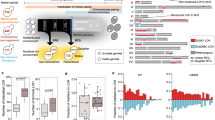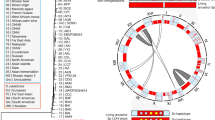Abstract
The chromosomal speciation model invokes chromosomal rearrangements as the primary cause of reproductive isolation1. In a heterozygous carrier, chromosomes bearing reciprocal translocations mis-segregate at meiosis, resulting in reduced fertility or complete sterility. Thus, chromosomal rearrangements act as a post-zygotic isolating mechanism. Reproductive isolation in yeast is due to post-zygotic barriers, as many species mate successfully but the hybrids are sterile2,3. Reciprocal translocations are thought to be the main form of large-scale rearrangement since the hypothesized duplication of the whole yeast genome 108 years ago4,5. To test the chromosomal speciation model in yeast, we have characterized chromosomal translocations among the genomes of six closely related species in the Saccharomyces ‘sensu stricto’ complex6. Here we show that rearrangements have occurred between closely related species, whereas more distant ones have colinear genomes. Thus, chromosomal rearrangements are not a prerequisite for speciation in yeast and the rate of formation of translocations is not constant. These rearrangements appear to result from ectopic recombination between Ty elements or other repeated sequences.
This is a preview of subscription content, access via your institution
Access options
Subscribe to this journal
Receive 51 print issues and online access
$199.00 per year
only $3.90 per issue
Buy this article
- Purchase on Springer Link
- Instant access to full article PDF
Prices may be subject to local taxes which are calculated during checkout


Similar content being viewed by others
References
White, M. Modes of Speciation (Freeman, San Francisco, 1978).
Naumov, G. Genetic basis for classification and identification of the ascomycetous yeasts. Stud. Mycol. 30, 469–475 (1987).
Hunter, N., Chambers, S. R., Louis, E. J. & Borts, R. H. The mismatch repair system contributes to meiotic sterility in an interspecific yeast hybrid. EMBO J. 15, 1726–1733 (1996).
Wolfe, K. H. & Schields, D. C. Molecular evidence for an ancient duplication of the entire yeast genome. Nature 387, 708–713 (1997).
Seoighe, C. & Wolfe, K. H. Extent of genomic rearrangement after genome duplication in yeast. Proc. Natl Acad. Sci. USA 95, 4447–4452 (1998).
Naumov, G., James, S. A., Louis, E. J., Naumova, E. S. & Roberts, I. N. Three new species in the Saccharomyces sensu stricto complex: Saccharomyces cariocanus, Saccharomyces kudriavzevii and Saccharomyces mikatae. Int. J. Syst. Bacteriol. (in the press).
James, S. A., Cai, J., Roberts, I. N. & Collins, M. D. A phylogenetic analysis of the genus Saccharomyces based on 18S rDNA gene sequences: description of Saccharomyces kunashirensis sp. nov. and Saccharomyces martiniae sp. nov. Int. J. Syst. Bacteriol. 47, 453–460 (1997).
Tamai, Y., Momma, T., Yoshimoto, H. & Kaneko, Y. Co-existence of 2 types of chromosome in the bottom fermenting yeast Saccharomyces pastorianus. Yeast 10, 923–933 (1998).
Ryu, S. L., Murooka, Y. & Kaneko, Y. Reciprocal translocation at duplicated RPL2 loci might cause speciation of Saccharomyces bayanus and Saccharomyces cerevisiae. Curr. Genet. 33, 345–351 (1998).
Ryu, S. L., Murooka, Y. & Kaneko, Y. Genomic reorganization between two sibling yeast species, Saccharomyces bayanus and Saccharomyces cerevisiae. Yeast 12, 757–764 (1996).
Naumov, G. I., Naumova, E. S., Hagler, A. N., Mendoncahagler, L. C. & Louis, E. J. A new genetically isolated population of the Saccharomyces sensu-stricto complex from Brazil. Antonie Van Leeuwenhoek 67, 351–355 (1995).
Naumov, G. I., Naumova, E. S. & Louis, E. J. Two new genetically isolated populations of the Saccharomyces sensu stricto complex from Japan. J. Gen. Appl. Microbiol. 41, 499–505 (1995).
James, S. A., Collins, M. D. & Roberts, I. N. Use of an rRNA internal transcribed spacer region to distinguish phylogenetically closely related species of the genera Zygosaccharomyces and Torulaspora. Int. J. Syst. Bacteriol. 46, 189–194 (1996).
Takezaki, N., Rzhetsky, A. & Nei, M. Phylogenetic test of the molecular clock and linearized tree. Mol. Biol. Evol. 12, 823–833 (1995).
Loidl, J., Jin, Q. W. & Jantsch, M. Meiotic pairing and segregation of translocation quadrivalents in yeast. Chromosoma 107, 247–254 (1998).
Hani, J. & Feldmann, H. tRNA genes and retroelements in the yeast genome. Nucleic Acids Res. 26, 689–696 (1998).
Boeke, J. D., Eichinger, D. J. & Natsoulis, G. Doubling Ty1 element copy number in Saccharomyces cerevisiae: host genome stability and phenotypic effects. Genetics 129, 1043–1052 (1991).
Kupiec, M. & Petes, T. D. Meiotic recombination between repeated transposable elements in Saccharomyces cerevisiae. Mol. Cell. Biol. 8, 2942–2954 (1988).
Rachidi, N., Barre, P. & Blondin, B. Multiple Ty-mediated chromosomal translocations lead to karyotype changes in a wine strain of Saccharomyces cerevisiae. Mol. Gen. Genet. 261, 841–850 (1999).
Codon, A. C., Benitez, T. & Korhola, M. Chromosomal reorganisation during meiosis of Saccharomyces cerevisiae baker's yeasts. Curr. Genet. 32, 247–259 (1997).
Adams, J. & Oeller, P. W. Structure of evolving populations of Saccharomyces cerevisiae adaptive changes are frequently associated with sequence alterations involving mobile elements belonging to the Ty family. Proc. Natl Acad. Sci. USA 83, 7124–7127 (1986).
Adams, J., Puskasrozsa, S., Simlar, J. & Wilke, C. M. Adaptation and major chromosomal changes in populations of Saccharomyces cerevisiae. Curr. Genet. 22, 13–19 (1992).
Bailis, A. M. & Rothstein, R. A defect in mismatch repair in Saccharomyces cerevisiae stimulates ectopic recombination between homologous genes by an excision repair dependent process. Genetics 126, 535–547 (1990).
Sniegowski, P., Gerrish, P. & Lenski, R. Evolution of high mutation rates in experimental populations of Escherichia coli. Nature 387, 703–705 (1997).
Sherman, F., Fink, G. & Hicks, J. Laboratory Course Manual for Methods in Yeast Genetics (Cold Spring Harbour Laboratory, Cold Spring Harbour, 1986).
Louis, E. J. in Methods in Microbiology; Yeast Gene Analysis (eds Truite, M. F. & Brown, A. J. P.) 15–32 (Academic, London, 1998).
Feng, D. F. & Doolittle, R. F. Progressive sequence alignment as a prerequisite to correct phylogenetic trees. J. Mol. Evol. 35, 351–360 (1987).
Saitou, N. & Nei, M. The neighbor-joining method: a new method for reconstructing phylogenetic trees. Mol. Biol. Evol. 4, 406–425 (1987).
Felsenstein, J. Confidence limits on phylogenies: an approach using the bootstrap. Evolution 39, 783–791 (1985).
Goddard, M. R. & Burt, A. Recurrent invasion and extinction of a selfish gene. Proc. Natl Acad. Sci. USA 96, 13880–13885 (1999).
Acknowledgements
We thank R. Borts and S. Chambers for helpful comments on the manuscript. This work was supported by the Biotechnology and Biological Sciences Research Council and the Wellcome Trust.
Author information
Authors and Affiliations
Corresponding author
Rights and permissions
About this article
Cite this article
Fischer, G., James, S., Roberts, I. et al. Chromosomal evolution in Saccharomyces. Nature 405, 451–454 (2000). https://doi.org/10.1038/35013058
Received:
Accepted:
Issue Date:
DOI: https://doi.org/10.1038/35013058
This article is cited by
-
Macroevolutionary diversity of traits and genomes in the model yeast genus Saccharomyces
Nature Communications (2023)
-
Multilayered mechanisms ensure that short chromosomes recombine in meiosis
Nature (2020)
-
A Saccharomyces paradox: chromosomes from different species are incompatible because of anti-recombination, not because of differences in number or arrangement
Current Genetics (2020)
-
Horizontal transfer and proliferation of Tsu4 in Saccharomyces paradoxus
Mobile DNA (2018)
-
Heterogeneous rates of genome rearrangement contributed to the disparity of species richness in Ascomycota
BMC Genomics (2018)
Comments
By submitting a comment you agree to abide by our Terms and Community Guidelines. If you find something abusive or that does not comply with our terms or guidelines please flag it as inappropriate.



